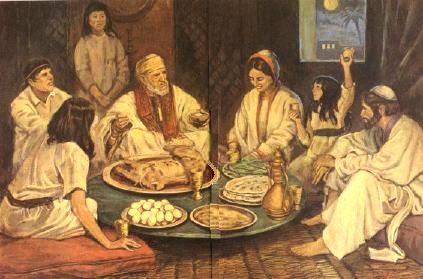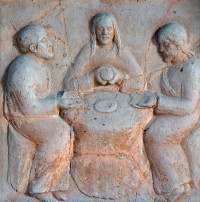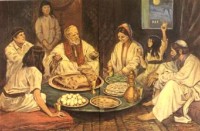The first “Lord’s Supper” was actually a Jewish Passover meal (cf. Matt 26:17-30; Luke 22:7-23). A typical Jewish Passover meal involves lots of food and wine, with numerous symbolic items and actions during the meal. It commemorates the deliverance of Israel from slavery in Egypt, and through the meal, Jesus is showing that in Him, all the world is now delivered from slavery to sin and death. The worldwide Exodus occurs in Him.

In the Gospels, there is no instruction from Jesus that the church should continue to practice and observe this meal. And even if there was, the Apostles and the early believers would have understood Jesus to be referring to the annual Passover meal, rather than a monthly, weekly, or daily observance.
Transitions to a Regular Meal
Yet something happened in the early years of the church so that by the time Paul writes 1 Corinthians, it appears that the believers in Corinth are regularly gathering to observe something called “the Lord’s Supper” (1 Cor 11:20). There were problems with the way they were observing the meal, and so Paul provides some corrective instruction about this meal (1 Cor 11:17-34). As part of these instructions, Paul refers to the Passover meal which Jesus shared with His disciples on the night before He was crucified (1 Cor 11:23-26). So somehow, in the span of a few decades, the Lord’s Supper goes from referring to the once-a-year observance of Passover to being a more frequent meal of fellowship with other believers.
It is difficult to know exactly how this transition occurred, but there is one likely theory. It is true that initially, the Lord’s Supper was a Passover observance. After Jesus died and rose from the dead, the new believers understood that the death and resurrection of Jesus was the central event in the history of the world, and that all Christian belief and practice focused around this pivotal event.
 At the same time, the early church was struggling to survive against persecution from the Romans and the Jews, and also striving to protect itself from false teachings about Jesus. There were also numerous people who had questions about Jesus and this new way of life that many people were being baptized into. Furthermore, one of the central practices and customs of Middle Eastern culture was fellowship and discussion around meals (cf. Acts 2:42-46). All of this together made mealtime the perfect opportunity to teach and answer questions about Jesus, encourage one another to stand strong in the face of persecution, and simply share food and fellowship with one another as was the custom.
At the same time, the early church was struggling to survive against persecution from the Romans and the Jews, and also striving to protect itself from false teachings about Jesus. There were also numerous people who had questions about Jesus and this new way of life that many people were being baptized into. Furthermore, one of the central practices and customs of Middle Eastern culture was fellowship and discussion around meals (cf. Acts 2:42-46). All of this together made mealtime the perfect opportunity to teach and answer questions about Jesus, encourage one another to stand strong in the face of persecution, and simply share food and fellowship with one another as was the custom.
Furthermore, since the death and resurrection of Jesus was central to Christian belief and practice, and since teaching was often done with the help of symbols, it probably became customary as a part of nearly every meal where Christians were gathered, to remind people that the bread they were eating represented the body of Jesus which was broken for them, and the wine they were drinking represented His blood. While early on, it appears that the believers met daily for this purpose (Acts 2:42-46), it seems that later on, they may have met once a week or so in a formal fashion (Acts 20:7-11).
By the time Paul writes 1 Corinthians, it appears that the tradition was firmly established that part of the meal of fellowship between believers included remembering the death of Jesus as symbolized by bread and wine.




There is another OT reference to the “Bread and Wine” that symbolized a covenant of peace – I have always felt this was also in mind when the bread and wine were chosen (rather than the lamb or herbs)….
“Then Melchizedek king of Salem brought out bread and wine; he was the priest of God Most High. And he blessed him and said:
“Blessed be Abram of God Most High,
Possessor of heaven and earth;
And blessed be God Most High,
Who has delivered your enemies into your hand.”
And he gave him a tithe of all.” – Genesis 14:18-20
One interesting question is when did the church decide to stop having the meal? It was the way the Apostles had church. Maybe they knew something we don’t 🙂
Thank you so much for this article. I fully agree with its content. If I may add something to it, that would be a reference to my article on celebrating Lord’s Supper after sunset on March 24 every year, whichever day it falls on. http://www.faithreaders.com/article-details.php?article=19070 Please read if interested.
Good teaching bro Jeremy. It is very refreshing to read about the relationship between LS and PO.
Teaching and peaching was the main occupation of our Lord and Savior JC.
The thoughts express by brother Jeremy are indeed according to the Holy scriptures, however my questions to answer are regarding the number of time the bread is broken before it get the participants and the number of cups used in the passover and if it doesn’t lessen the practical fellowship of each person actually break the bread for their self, and the same with the cup. Scriptures clearly state “the bread and the cup”